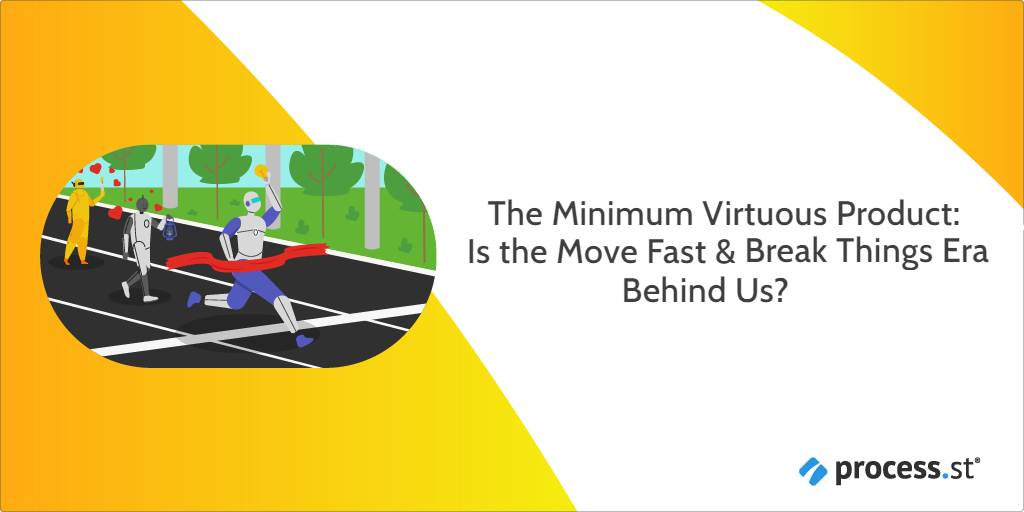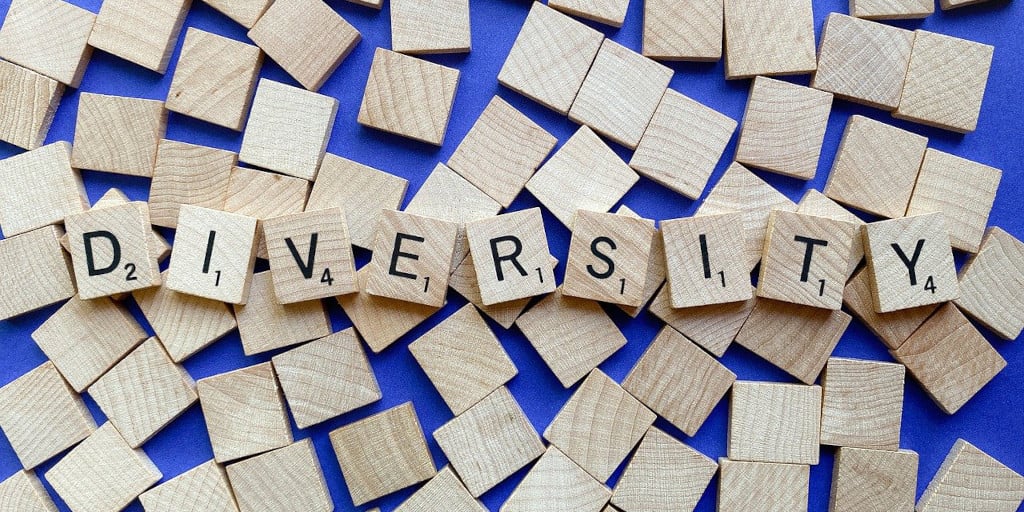 If you’re moving fast and breaking things, at what point in time do you realize things are broken?
If you’re moving fast and breaking things, at what point in time do you realize things are broken?
When there is public uproar against your product? Such as the Amazon case in 2019 involving job listings for the role of “union buster” (someone who reports on fellow employees seeking fair labor practices).
Or, when regulators come down on you like a ton of bricks? As was (and continues to be) experienced by Airbnb whose platform has been home to grotesque racial discrimination.
Allow me to introduce the topic of this blog post: The minimum virtuous product (MVP).
It seems the concept behind the traditional minimal viable product (MVP) which prioritizes quick launches and basic feature sets has been replaced by something a little more virtuous. The new MVP, minimum virtuous product, encourages companies to focus on diversity and transparency by building morally sound design principles, from the start.
This post will take a look at what this change in acronym has to do with the way companies grow and scale; along with an eight-question framework that will help start-ups assess the social impact of their products; and finally, it will cover what moving with virtue could mean for future startups.
To skip to a specific section of the post click on the appropriate link below:
- Minimum viable product vs minimum virtuous product
- Is your product virtuous? 8 questions to ask
- Why you need a minimum virtuous product: Real world examples
- What does moving with virtue mean for future startups?
- Minimum virtuous product: Conclusion
Alternatively, just keep scrolling to read the whole post.
Minimum viable product vs minimum virtuous product
In 2017, my colleague Adam Henshall wrote:
“The term MVP has become a bit of a buzzword within the startup scene as everyone tries to follow the lean playbook. There have also been conceptual disagreements about what an MVP really is, what it should do, and what other approaches are better.”– Adam Henshall, How to Build an MVP App Without Writing Code
Evidently, the speculations about what an MVP is and what it should do have only heightened over the last few years. While this post does not have the breadth to fully delve into this discussion, it’s worth me providing some information about what a minimum viable product is.
Coined by Frank Robinson in 2001, and made popular by Eric Ries through his book Lean Startup (think: Agile), the minimum viable product has become a core component within the product development process for teams like Google, Apple and Netflix.
“The MVP is the right-sized product for your company and your customer. It is big enough to cause adoption, satisfaction, and sales, but not so big as to be bloated and risky. Technically, it is the product with maximum ROI divided by risk. The MVP is determined by revenue-weighting major features across your most relevant customers, not aggregating all requests for all features from all customers.” — Frank Robinson, How it Works: Minimum Viable Product
In other words, the minimum viable product enables companies to create an impact without having to go big. It flips the traditional model of “bigger = more impact” on its head. Ultimately, the minimum viable product has changed the value that we put on scale. To scale rapidly no longer equals success.
Talking of scale… to learn how Ryan Hoover, Founder of Product Hunt, acquired over 2000 users by doing things that didn’t scale. Check out this episode of our podcast Tech Out Loud.
Tech Out Loud is the only podcast that brings you the most impactful blog posts from the biggest names in tech, straight to your ears.
You can also listen to this podcast on other platforms. Click to see the full list! If you enjoyed this podcast, subscribe for a new episode each week.
Hemant Taneja, the brains behind the minimum virtuous product and author of “Unscaled“, is an advocate for responsible innovation. He believes it’s time for start-ups to stop “moving fast and breaking things” (a motto brought to fame by Mark Zuckerberg) and start moving virtuously by considering the social ramifications of their products.
His aim is to move away from the rapid growth and scale mentality and bring the human back into MVP.
The issue of scale and where it all began
Taneja describes how for 100 years we have used scale as a metric for success. We scaled education, healthcare, and finance so everyone in the US could have basic access.
For many years, this growth has had positive outcomes:
- There are now more kids in school than ever before.
- Healthcare has become more accessible, lessening the number of fatalities at the hands of curable diseases.
- Access to financial services is no longer limited to the more affluent members of society.
Nevertheless, according to Taneja, scale has run its course.
Let’s use healthcare as an example. Rewind to 50 years ago, healthcare was restricted and only accessible to those who could afford it. The wealthy relied upon their family doctor who knew each of his/her patients intimately, and who took time in caring for each and every one of them.
Today, if you visit a hospital, you wait in a crowded waiting room (pre-covid) and are rushed through your appointment with a physician, who barely knows you, and you are unlikely to know. The appointment lasts little to no time at all and the physician spends the majority of their time typing notes into their electronic medical records (EMRs) rather than connecting with you, the patient. A far cry from the care you would’ve received from the family doctor.
What does this mean?
It means we have taken the “human” out of the sector that, if anything, should be the most human of all.
“We’ve literally taken every one of these important services in society and scaled them to the breaking point. The banks have failed small businesses and large segments of consumers. The health care system is bankrupting us. We are not preparing our kids for the twenty-first century. The power sector has contributed significantly to climate change. – Hemant Taneja, An interview with Hemant Taneja
However, over the last ~twenty/twenty-five years, there has been a secular shift to organize content, community, and commerce online. And, it is this shift that Taneja feels provides us with the opportunity to rethink how we provide the basic services (like health care) that are fundamental to our society.
This shift has also brought technology into the limelight. Why? Because nowadays technology is front and center in the majority of industries, not only the basic services like education, health, and finance.
Within industries where the markets are so large and have been scaled to such an extent that they are near breaking point, cracks start to emerge. And, it is startups that are filling these gaps with minimum viable products.
The issue is that the recent monopolization of these industries by technology, minimum viable products, and startups has not been controlled or monitored by regulators until recently. And, when these newcomers get it right, they get access to $100 billion+ markets and all their consumer data.
According to Taneja, because a company can make an impact without mass scale and growth, there’s a necessity for more consideration around the social impact of the products they release into the world. The “Wild West” approach startups take when moving fast is often void of consideration of future social ramifications their products may have. Consumers should be made aware of exactly what they are giving away and be told, in simple terms, how their data will be used.
What’s more, startups should ask questions that incorporate the social aspect of growth further into their strategies. They should make a conscious effort to adhere to regulations that restrict the use of consumer data, regulations that promote transparency, diversity, and inclusion (such as the Corporate Social Responsibility (CSR) practices larger enterprises adhere to).
These regulations can help to avoid worst-case scenarios like exploitation, gentrification, and racism. All of which have been present in companies like Airbnb and Amazon. Sometimes, it’s the end-user or consumer who is the perpetrator, other times it’s the way in which the product is distributed that has a negative social impact. I’ll go over these cases later in the post.
For now, let’s take a look at Taneja’s questions which form the framework behind the concept of the minimum virtuous product.
Is your product virtuous? 8 questions to ask
To make the shift from building a minimum viable product to creating a minimum virtuous product, Taneja suggests we apply a framework that asks the following questions:
1. What systemic, societal change do you wish to create with your product?
Think about the social impact of your product and consider how other technologies, trends, and stakeholders map out their social vision for the future.
2. How will you sustain the virtue of your product?
As DJ Patil, the former U.S. Chief Data Scientist argues: the goal should not be perfect clairvoyance, but rather reasonable foresight. To sustain the virtue of your product, be sure to anticipate and prevent its worst-case scenarios (more on this in the next section).
Let’s take social media as an example: Facebook’s virtue has been damaged by a small number of iniquitous users who have caused major harm (think: cybercrime).
3. How do you drive the greatest impact on an individual level?
I discussed the topic of impact and scale in the previous section. Considering that innovators, through technology, can achieve impact at breath-taking speed, it’s important to consider exactly what that impact will be.
In other words, consider how you will ensure that you positively impact narrower slices of customers more precisely and effectively. And, how will you ensure that your product doesn’t have a negative impact on humanity as a whole, not just your user base?
4. What do you think is an optimal growth rate? How will you keep yourself accountable as you scale?
The faster you move the harder it is to remain accountable as you do so. The trick is to make sure that your optimal growth rate considers (and incorporates) the following key factors:
- The required pace of hiring;
- The complexity of services delivered;
- The capital intensity of expansion;
- The size, maturity, and competition in the market.
5. What’s your framework for leveraging data and AI responsibly?
To avoid consumer backlash founders should ensure transparency when it comes to how they use consumer data.
“If a founder can articulate their complex AI footprint in simple, understandable, and honest terms, their products will be more sustainably successful. Needless to say, this is predicated on a founder understanding their AI’s results themselves.” – Hemant Taneja, The Era of “Move Fast and Break Things” Is Over
6. Does your business foster an ecosystem in which innovation thrives?
To avoid restrictive regulation you want to try to create an environment where the economic value reaped by everyone that uses your product exceeds the value of your company itself. As Taneja states: “creating shared value exceeds innovation.”
7. How do you define and promote diversity in the context of your business?
Prioritizing diversity will help you to stand out from other startups. If you plan to prioritize diversity and inclusivity be sure to walk the walk, as well as, talk the talk.
I mentioned in a previous post how, more often than not, companies claim to promote diversity, but when push comes to shove, they fall at the first hurdle. In the post, I gave the example of Starbucks, which in 2020, publicly stated allegiance to the Black Lives Matter movement and then, in contrary to their statement, punished its employees who openly supported the cause.
8. How does your company dynamically evolve in response to regulation and account for the various stakeholders your product impacts?
Despite entrepreneurs treating regulation as something to be worried about, regulation, when done right, is not inherently bad.
As startups grow more omnipresent and more powerful, and technology becomes more innovative and more difficult to understand, the threat of bad regulation grows. This means that if you don’t engage with the policy debate, then regulator attention could turn towards overcorrection, destroying economic value, and crippling competitiveness.
Why you need a minimum virtuous product: Real world examples
The following examples aim to make the case for a more virtuous approach to growth as companies (particularly startups) “move fast” when bringing their products to market.
Often, if more attention had been given outright to the social implications a product could have, the worst-case scenarios – like those experienced in the cases below – could have been avoided.
Amazon
Amazon, which started off as a startup, has experienced its fair share of public outcry and penalization from regulators. I’ll avoid going into detail into each of the cases (for more information follow the links below). However, one common thread in each of these scenarios is that they could’ve been avoided if Amazon had asked questions that considered the social implications (like those featured above) of their strategy:
- Amazon Pushes Fast Shipping but Avoids Responsibility for the Human Cost:
Civilian deaths at the hands of Amazon’s delivery drivers. - After Public Outcry, Amazon Deletes Listings for 2 Intelligence Jobs That Involved Tracking ‘Labor Organizing Threats’:
Amazon accused of searching for “snitches” to rat out employees who oppose the company’s labor practices. - Amazon to Bring Same-Day Delivery to Bronx, Chicago After Outcry:
Amazon’s speedy delivery services only available to more affluent neighborhoods.
Interestingly, the last scenario was an outcome of an algorithm created to find the ZIP codes that had the most demand of Amazon’s products. The neighborhoods with the highest demand tended to be affluent white communities, and thus, these communities received fast delivery/other benefits. While other neighborhoods, with less demand and with a high black population, did not. The algorithm did its job, however, in doing so it socially excluded minority groups.
Airbnb
For years there has been an outcry for Airbnb to stop prioritizing multiple advertisers, specialized real estate agents, and brokers, over single private tenants.
Recent research from the University of Pisa reports that today the greater part of the revenues obtained through the platform is gained by the very few big players, rather than the majority of its users, the single private tenants.
The consequence is that the human dimensions of its service fail and Airbnb becomes a channel to promote short-term rentals, without the presence of regulation to protect the surrounding residential area and its residents.
Some examples from the University of Siena’s research include Florence, where hosts earn on average €5,314 per year. However, a closer look at the research shows that €700,000 of that average belonged to just one single host. Similarly, in Milan, over four thousand hosts earn an average of €1,600 a year, but once again, one particular host earns more than half a million euros.
The social ramifications of this are numerous. Airbnb is being used as a tool to reinforce social inequality and enable the unfair distribution of wealth. And, as you’d expect, residents being affected by these practices have had enough. The growing citizen’s protests all over the world and the attempts of the public administrations to fill the legislative gap by intervening at the regulatory level reflect this.
Another example of social exclusion at the hands of the platform includes the numerous cases of racism perpetrated by the end-users themselves. Airbnb hosts have been known to reject black users despite the dates for their stay appearing as available.
To make matters worse, in the instance where black users replace their pictures with that of a white person they have found that suddenly, they are able to book those same dates that just moments before were unavailable to them.
The case of Airbnb highlights a key factor in the move to becoming more virtuous: the role of stakeholders.
What does moving with virtue mean for future startups?
The scenarios experienced by Airbnb highlight the impact each stakeholder can have on the virtue of a product. The company itself enables gentrification and the unfair distribution of wealth; the end-users are also perpetrators through their racist exclusionary practices; and, there is a severe lack of regulation (and input from regulators) to protect society from the social inequality experienced at the hands of the platform.
My findings, particularly those relating to the Airbnb case, brought two questions to mind:
- How do we stop this?
- How can the companies that were moving fast and breaking things, start to become more virtuous?
For starters, there is a need for diverse points of views around the table when a new product is being developed. This will help to ensure that all corners are covered.
Companies should begin by defining what diversity means for them, consider demographics, generations, and sexual orientation. Then ensure, that when building a team, they recruit across all of these dimensions.
In the move to be more virtuous, regulators, consumers, and companies should play a key role:
Companies should ask the questions and implement the framework suggested by Taneja and embody the new MVP: Minimum virtuous product.
Consumers should educate themselves so they know what data they are giving away, and to who. They should strive to have an educated understanding of AI and technology to help ensure that they elect the right government bodies and regulators.
Regulators should ensure accountability and restrict companies, particularly startups, from flouting the rules. Taneja states that a specific set of regulations should be created for startups. The minimum virtuous product has to include regulation, so there is no option to skip out on the rules. This means that companies will have to think about how they will comply.
Ultimately, when looking to the future, Taneja suggests that:
“At a minimum, founders must know who the key decision makers in their market are and think through how and when it makes sense to engage with them. Transactional relationships, born of crises, are neither effective nor worthwhile. Continual, consistent dialogue leads to better-informed regulators and better regulatory regimes.” – Hemant Taneja, The Era of “Move Fast and Break Things” Is Over
Minimum virtuous product: Conclusion
Making short-term decisions that favor your own company despite being fully aware of the negative consequences these decisions could have for society in the future will have a backlash. The move fast and break things mindset is great for growth, yes. But, when embodying this mentality, startups often forgo the corporate social responsibility dimension that larger enterprises have to adhere to. Meaning that “moving fast” can be counterproductive in the long run when things start to “break”, as demonstrated by both Airbnb and Amazon.
In order for startups to scale successfully, the social ramifications of their products should be considered from the get-go. To do this they can start by asking Taneja’s eight questions, following his framework, and adhering to regulations.
“It’s time to update the MVP acronym from Minimum Viable Product to Minimum Virtuous Product. Companies should strive to build morally sound design principles from the start with accountability, explainability, and transparency.” – All Turtles, Unscaled 4: The Minimum Virtuous Product
If you found this content useful and interesting, sign up to our blog (it’s free) for access to our future content and to learn more about what Process Street does.
I’d love to hear your thoughts on this. Is it high time the tech industry became more virtuous? Do you think the move fast and break things era is behind us? Let me know in the comments.







 Workflows
Workflows Projects
Projects Data Sets
Data Sets Forms
Forms Pages
Pages Automations
Automations Analytics
Analytics Apps
Apps Integrations
Integrations
 Property management
Property management
 Human resources
Human resources
 Customer management
Customer management
 Information technology
Information technology







Molly Stovold
Hey, I'm Molly, Junior Content Writer at Process Street with a First-Class Honors Degree in Development Studies & Spanish. I love writing so much that I also have my own blog where I write about everything that interests me; from traveling solo to mindful living. Check it out at mollystovold.com.